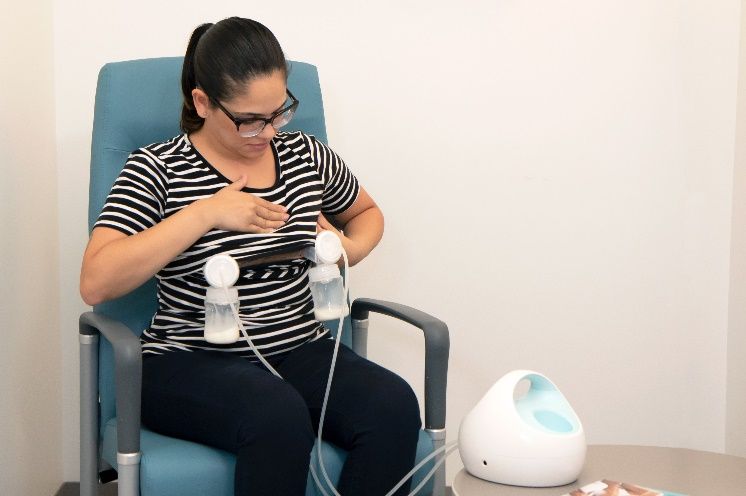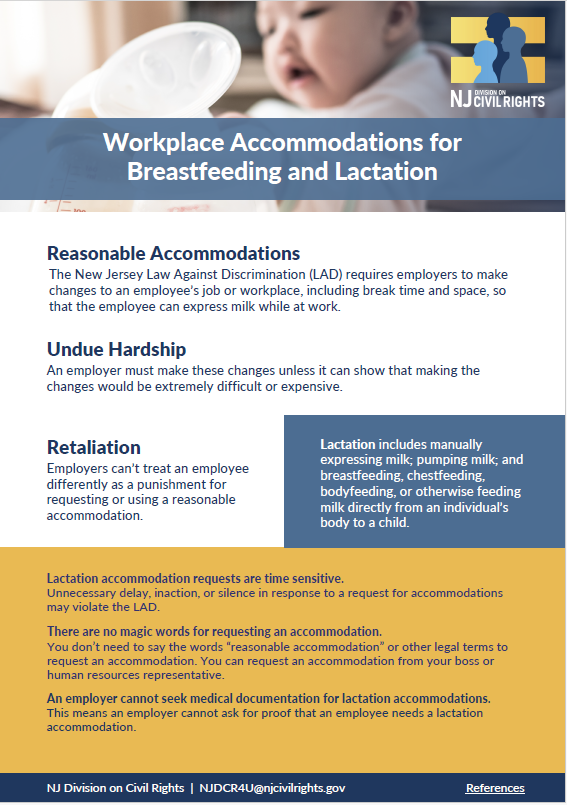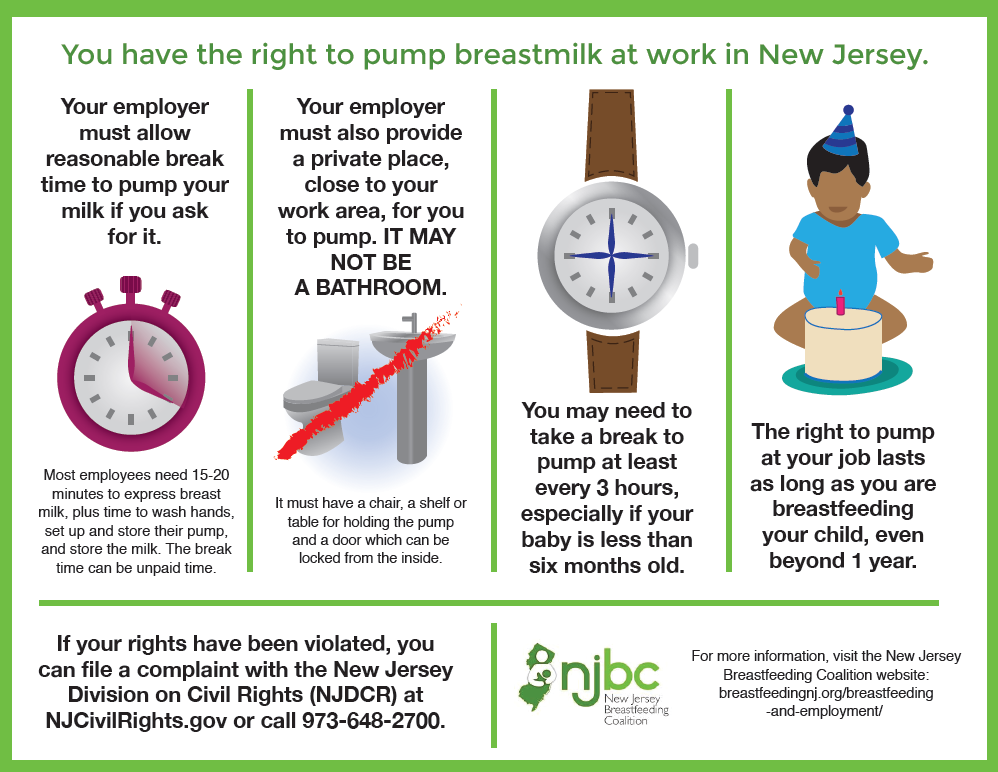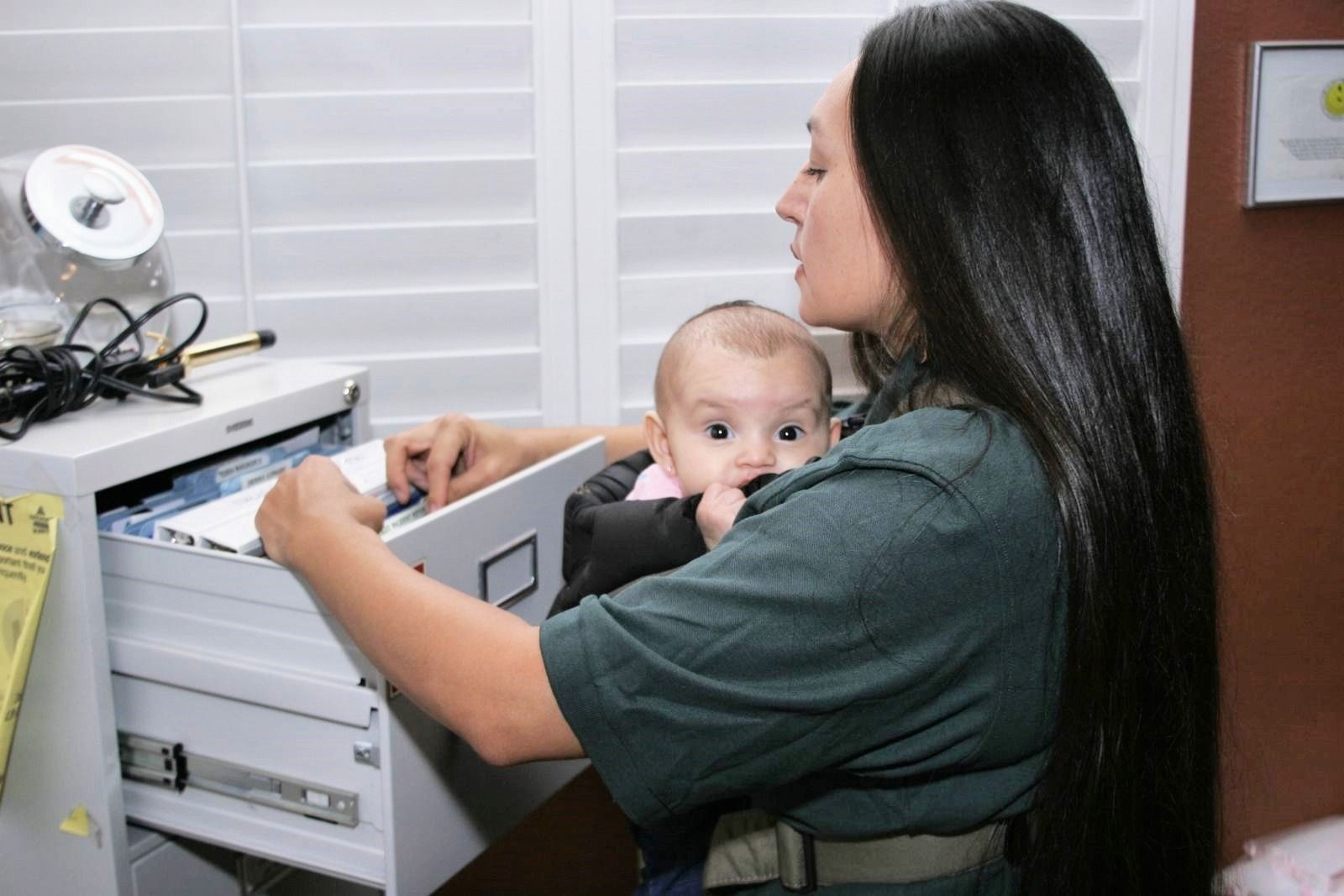Returning to Work
Returning to work while continuing to breastfeed often leads to a mix of emotions – pride, exhaustion, and determination. On the one hand, there is a sense of accomplishment in being able to balance providing the best possible food and nutrients for your baby with providing financially for your family. On the other hand, issues such as an early return to work, adjusting to a new routine, pumping at work, and managing supply may seem challenging. For many parents, returning to work shortly after a baby is born is the only option available due to economic need. Black and Hispanic parents are often overrepresented in service, retail, hospitality, home care, and other low paying jobs where paid maternity leave is rare and schedule flexibility or job security is less common.

Your efforts to continue feeding your baby human milk are acts of love, resistance, and strength. With time, you will find a rhythm that works for you. Cooperation from your employer and a well-organized plan can make the transition smoother. No matter what, it is a journey of patience and flexibility.
Timeline and Steps for Returning to Work
Use this guide to help you plan what may be needed and the steps you will need to take as you prepare to continue providing your milk as you return to the workforce.
At least 1 month before my due date
Continue preparing to get off to a good start. Notifiy your employer If you are planning to take Temporatry Disability leave before and/or after the baby is born and Paid Family Leave for bonding after the birth. See New Jesey Paid Family Leave Benefit Programs for Pregnancy, Recovery, and Bonding above for more information on these benefits.
Speak with your supervisor or human resources representative about your return-to-work needs. Be sure to prepare to discuss the following:
- Your desire to continue providing human milk for baby
- Available options for a gradual return to work, such as temporary part-time work, working from home some days of the week, returning work on a day near the end of the usual work week (Wednesday, Thursday or Friday)
- Private space to pump
- Break time for pumping during the work shift, as required by law
- New Jersey workplace lactation rights according to the law
Begin looking into possible childcare options for your baby. Use this how-to guide to help familiarize yourself with more information and resources and visit our Childcare section below for more information.
1-2 weeks before returning to work
- Keep track of how often your baby eats during the day for a few days before returning to work or school. This will help you know when you will need to plan to pump your breastmilk while you are away from your baby. If your place of employment does not have a designated lactation room, ask your employer to identify a private space that will be avaiilable to you to express milk when needed.
- Practice using your pump and storing milk.
- Consider starting baby in childcare before your first day back at work to ease the transition for both you and your baby.
1 day before returning to work
- Ensure your pumping bag contains the following necessary items: breast pump, pump parts (flange, tubing), bottles, human milk storage bags, insulated cooler and cold packs (if access to a refrigerator is unavailable), with and hand sanitizer.
Tips for Pumping at Work
Expressing human milk during the workday to maintain milk supply and ensure your baby has enough to eat may take effort but it is more than possible. Many women use their regular breaks and lunch break to pump. Some women come to work early or stay late to make up the time needed to pump.
What will I need to succeed at pumping breast milk at work?
- Reliable pump that you have practiced with at home
- Pumping bra (if you are unable to purchase one, consider cutting holes in a sports bra so the flange stays fitted to your breast)
- Private place to pump
- Place to store your milk (refrigerator, insulated carrier with cold packs, etc.)
- Labels and a marker to identify your pumped milk
What is a sample pumping schedule?
8:00am – Breastfeed at home before leaving work
9:00am – Arrive at work
11:00pm – Use part of lunch break to pump
1:00pm – Afternoon pumping break
4:00pm – Late afternoon pumping break
5:30pm – Breastfeed baby at sitters or immediately after returning home
How do I clean and sanitize pump parts while at work?
Carefully cleaning breast pump parts after every use is important to prevent germs from contaminating the milk you feed your baby. Access to a clean sink or basin and washing with soap and hot water is essential. Use this CDC guide in English and Spanish for more detailed information.
Sometimes cleaning breast pump parts at work may require creative solutions depending on your workplace. Here are some ways that you might handle these challenges:
- Bring multiple breast pump kits to your workplace so you can use a clean kit for each pumping session. Take used parts home after work and wash them all at once.
- If you have access to a microwave, rinse parts and then use steam bags made for cleaning breast pump parts. Some pump parts should not be steamed in the microwave, so be sure to check the manufacturer's instructions.
- Learn how to hand express directly into milk collection containers.

Workplace Lactation Rights in New Jersey
The New Jersey Law Against Discrimination (LAD) requires employers to provide reasonable workplace accommodations to pregnant, breastfeeding, and lactating employees. These accommodations include changes to the employee's job and workplace and providing break time each day and space that will allow them to express milk at work. The employer must make these changes unless it can show that doing so would cause an undue hardship or be extremely difficult or expensive. The LAD also prohibits discrimination or retaliation against or unequal treatment of a pregnant or lactating employee. The LAD covers all New Jersey employers of any size, except for federal government employers. The LAD does not cover independent contractors.
For federal government employees, the PUMP for Nursing Mothers Act (PUMP Act) requires workplace lactation accommodations. See more information on the PUMP Act below.
Frequently Asked Questions about the New Jersey Law Against Discrimination
What workplace lactation accommodations does the New Jersey Law Against Discrimination require?
The New Jersey Law Against Discrimination requires employers to provide reasonable accommodations to breastfeeding and lactating employees which include, at a minimum:
- Reasonable break time to express milk.
- A private place to express milk (pump) other than a bathroom stall, that is close to the employee’s work area.
The employer must trespond to requests for accommodations without delay. Under the LAD, employers must also grant other reasonable breastfeeding-related accommodations to enable the worker to express milk if the worker asks for them unless they would cause an undue hardship. For example, an employee may need changes to their work responsibilities, uniform or schedule to accommodate their pumping needs.
What does "reasonable break time" mean?
According to the New Jersey Division on Civil Rights, reaasonable break time may vary based on the worker's and their child's needs. Employees may need to express milk as often as they would nfeed their baby at home.
The length of the pumping breaks may also vary depending depending on the employee's and workplace circumstances. While pumping sessions may typically last 15-20 minutes, some employees may need more time depending on their pump or other factors. The employee also will need time to assemble and take apart and wash pump parts, store the milk, and travel to and from the pumping location.
What is a suitable place for expressing milk according to the LAD?
The LAD requires a place with privacy to express milk that is nearby the employee's work location. The space does not need to be designated only for pumping, but it should be available when the employee needs it. The space should be clean, well ventilated and should include, at a mininum:
- A seat or suitable place to sit
- Flat surface on which to place a pump
- An electrical outlet
- A nearby sink or other source of running water
- A close-by refrigerator or cooler to store the expressed milk.
Employers with limited space should think creatively to provide an appropriate private space for expressing milk.
Does the LAD include a time limit on the right to express milk at work?
The LAD does not include a time or child age limit on the pumping accommodation.
What anti-discrimination protections does the LAD provide for breastfeeding and lactating employees?
The LAD prohibits employers from punishing, threatening, or retaliating against employees who seek accommodations. The law also forbids an employer from creating a hostile work environment for the employee who asks for an accommodation.
Do I need to give my employer a note from my health provider to prove that I need these accommodations?
No. Under the LAD, an employer is not allowed to ask you for medical proof that you need a lactation accommodation.
What should I do it I think my rights have been violated?
If you have tried to resolve the issue with your employer without success and feel your rights may have been violated, you can file a complaint with the New Jersey Division on Civil Rights (DCR) which will investigate your claim. If the DCR finds that your claim is valid, it can order remedies including money damages, job changes or reinstatement. It can also order other relief to prevent discrimination or harassment from happening again. Find more information on the DCR website.
Alternatively, you can file a complaint in the Law Division of the New Jersey Superior Court. If the court finds the LAD was violated, it can also order the above remedies and punitive damages.
Law Against Discrimination Resources
New Jersey Division on Civil Rights
- Pregnancy, Breastfeeding, and Reproductive Rights landing page
- Guidance on Workplace Accommodations for Pregnant, Postpartum, Breastfeeding, and Lactating Employees
- Handouts:
- Workplace Accommodations for Breastfeeding and Lactation (Also available in Chinese (Simplified) | Chinese (Traditional) | Gujarati | Korean | Portuguese | Spanish)
- 5 Things You Should Know About Accommodations for Pregnancy and Breastfeeding at Work
New Jersey Breastfeeding Coalition
- Infographic: You have the right to pump breastmilk at work in New Jersey (English) (Spanish)
- Employee’s Fact Sheet: Workplace Breastfeeding Rights in New Jersey
- Employer's Fact Sheet: Workplace Breastfeeding Rights in New Jersey
Other Resources
- A Better Balance--Talking to Your Boss About Your Pump: New Jersey
- A Better Balance--free confidential workplace rights helpline: 1-833-633-3222 and contact form
- New Jersey Education Association. Lauren Zucker, PhD. Pumping at Work: What All Educators Need to Know.


Workplace Lactation Rights for Federal Employees under Federal Laws
The PUMP for Nursing Mothers Act requires federal employers and nearly all other employers of all sizes to provide reasonable break time and a clean, private space to express milk for up to one year following the birth of the employee's child, unless it creates an undue hardship for the employer. The lactation space may not be a bathroom, and it must be that is shielded from view and free from intrusion from coworkers and the public. if the employee is not completely relieved from their work duties during the pumping break, employers must count pumping time as work time for workers who are paid hourly and eligible for overtime. If an employee feels their PUMP Act rights have been violated, the employee may file a complaint the U.S. Department of Labor Wage and Hour Division by calling the toll-free number or by visiting the Division's website. Alternatively, the employee can file a lawsuit against the employer. For more information, see the Department of Labor's website.
Employees can also seek other reasonable lactation-related accommodations from their employer under the Pregnant Workers Fairness Act (PWFA). The PWFA requires employers with 15 or more employees to provide reasonable accommodations to employees with lactation related conditions unless it creates an undue hardship for the employer. Find more information on the PWFA on the
U.S. Equal Employment Opportunity Commission website.
New Jersey Paid Family Leave Benefit Programs for Pregnancy, Recovery, and Bonding
Having time off from work to care for yourself during pregnancy and to care for both you and the baby after childbirth leads to better health outcomes, promotes bonding, and helps get breastfeeding off to the best start. Three New Jersey programs are available to provide paid leave time to eligible parents so that taking time off is possible. Most New Jersey employees are eligible.
- Temporary Disability Insurance (TDI) provides cash benefits when expectant mothers and parents need to stop working before the delivery date and while recovering from childbirth.
- Family Leave Insurance (FLI) provides cash benefits for up to 12 weeks of time off after temporary disability ends so new mothers and parents can bond with their babies during the first year. FLI is available for the father and partners to use before the baby’s first birthday.
- Earned Sick Leave provides full-time, part-time, and temporary employees with up to 40 hours of earned sick leave per year so they can care for themselves or a loved one.
If you are eligible, TDI and FLI provide 85% of your average wage during your time off. Learn more at the NJ MyLeaveBenefits website.
This easy-to-use Maternity Coverage Timeline Tool will help you estimate the dates you're covered by New Jersey paid leave benefits.
Learn more about Earned Sick Leave benefits and eligibility here.

New Jersey Family Leave Act (NJFLA)
Many workers can have their job protected during their paid leave time. The New Jersey Family Leave Act (NJFLA) is a law that allows you to take up to 12 weeks of job-protected leave from work every 24 months to care for a baby, family member, or handle family issues. While it does not provide pay, it does protect your job while on paid leave. The federal Family Medical Leave Act (FMLA) also provides certain employees with up to 12 weeks of unpaid, job-protected leave per year with health benefits.
Learn more about how these laws work together with the state’s paid family leave benefits to protect your job while caring for yourself or a loved one on this MyLeaveBenefits job protection information page.
Additional Information for Employers
There is great value in supporting breastfeeding employees in the workplace. Creating a supportive workplace for breastfeeding and chestfeeding mothers isn't just about compliance - it's about valuing the health of both parent and child. With the right policies and compassion, breastfeeding employees returning to work will feel empowered and have better job satisfaction allowing them to complete their work successfully.
Why should employers support breastfeeding?
- Creating a healthier workforce – breastfeeding leads to healthier babies and parents, reducing the number of sick days taken and increases productivity
- Employee retention – companies experience less employee turnover and higher employee morale because mothers are more likely to return to work when they know they can continue to breastfeed
- Improved employer productivity – when given the support they need, breastfeeding employees do not need to worry about finding time or space to pump, which leads to better focus on the job.
- Legal compliance – New Jersey has laws that require employers to provide accommodations for breastfeeding, such as time and private space for pumping. Supporting breastfeeding ensures employers are compliant with these regulations and avoid legal issues.
How do I support breastfeeding in the workplace?
- Reach out to the New Jersey Breastfeeding Coalition for guidance and resources. Breastfeeding coalitions can often support companies with implementing a lactation program or creating a lactation room.
- Place a “Breastfeeding is Welcome Here Sign” in a common space can help normalize the idea so breastfeeding parents do not feel embarrassed or fearful of losing their jobs.
- Check with your company’s primary insurance carrier to explore policies and benefits for breastfeeding employees. Insurance companies may cover breastfeeding resources and services such as consultations from a lactation consultant, breast pumps, a home visiting nurse during the early postpartum period, and breastfeeding supplies.
- Allocate space for a lactation room. The amount of space needed for a lactation room is minimal. It does not require a full-sized office but does need to accommodate a chair, a small table or shelf for a breast pump and have the ability to be locked. It can be a room or space used for other work functions, like an office, conference room or storage area.
- Allow break times to pump. Most mothers will need to pump as often as the baby normally feeds, or at least every 3 hours, especially when their babies are under 6 months of age. The pumping frequency needs may change as the baby’s feeding pattern changes or when the baby starts to eat solid foods.
For more information on parents’ rights to breastfeed in the workplace, please click here.
Child Care Providers
Child care staff play a crucial role in supporting the health and wellness of children. For babies, the optimal source of nutrition is human milk. Babies fed human milk have fewer illnesses and thus spread less sickness to other children and staff in child care. Lactation-friendly practices attract more families to the facilities that offer them. Child care centers in the federal Child and Adult Care Food Program can receive subsidies for human milk feedings given to infants in their centers.
New Jersey Breastfeeding Coalition has developed two valuable educational resources:

- Becoming a Breastfeeding-Friendly Child Care Provider – a free one-hour long training with continuing education credits available in English and Spanish for child care providers in center-based and family home care settings
- Breastfeeding Babies Are Welcome Here: Creating Breastfeeding-Friendly Child Care in New Jersey - guide and toolkit to help child care providers learn how to support parents and their babies.
A companion resource by Montclair State University to help parents prepare themselves and their breastfeeding baby for child care, Breastfeeding Works: Sending Your Breastfeeding Infant to Child Care in New Jersey, can also be downloaded from the New Jersey Breastfeeding Coalition child care landing page.





